#PP: Jasmine Rai
Explore tagged Tumblr posts
Text



The party was a hit, with lots of old friends showing up. Johnny Smith and Almeric were dormed together all those years ago when they first started college! They enjoyed the chance to catch up on life over a few slices of pizza.
Jasmine's quick to catch her old friend Johnny up on her life, evidently still kind of pissed at Zoe cheating on her in senior year. Almeric remembers she and him hooking up that one time, but decides its probably not worth bringing up in company.
#Pleasantview Plus#University: LFT#Household: Oresha Hoh Var#PP: Almeric Davis#PP: Johnny Smith#PP: Jasmine Rai#PP: Frances Worthington#PP: Guy Wrightley
19 notes
·
View notes
Text



Well, it took like two weeks longer than it should have, solely because I wanted to collect the legends this time and Raikou is a pain in my ass. But I finished Crystal. Commentary under the cut.
Ledian was, for all intents and purposes, my starter. I wound up breeding for Psybeam off Venomoth (yes, I used Dupe Glitch to get the Rare Candies to get that done in a reasonable timeframe, don't worry about it), and gave it Thunderpunch/Ice Punch as its other moves. Light Screen was the final, but if I could do it all over, I would've kept Reflect instead. Ledian wound up pretty good. Its offenses left a lot to be desired, but its defenses made up for it a bit. Special Defense in a game where all moves of a type are special means you can wall out a good number of fights just fine. In short, even Lance fears the bug, because Thunderpunch is excellent against Gyarados, and Ice Punch can destroy Dragonite. The real selling point is that Ledian has a fast level up rate. If I could do anything different, I might have just put more time into Ledian, because it really has an excellent time against a lot of threats in this generation. Bless the elemental punches.
Bellossom, my sweet baby who took forever to find for some reason, was...okay. Sleep Powder is devastatingly powerful this game, so as long as she gets a hit in, she did well enough. One run of the League, I managed to take out four of Lance's Pokemon just with Bellossom. Petal Dance/Sludge Bomb/Moonlight/Sleep Powder can get you a lot of mileage, though it is funny that Gen 2 is the way it is, resulting in Moonlight not recovering much if the time of day isn't night. The main hiccup is that Petal Dance can be really hit and miss, and a lot of her matchups that I wanted to be better weren't solely because Petal Dance was just shy of a 2HKO. Queen of infuriating ranges, this plant.
Umbreon is my wife's favorite Eeveelution, but I admit it's always taken a back seat with me. I'm 100% and Espeon player. But I decided that this run was, in part, finding Pokemon that are good at counterpicking certain sets. And Umbreon...you know, I actually really like it. It tanks incredibly well, and has enough offensive power to respond decently well. It counters Will complete, is quite helpful against Koga, did well with Karen thanks to Headbutt before reaching Moonlight level, and can be an effective option against some of Lance's team. Faint Attack is great against Red's Espeon, since it negates his only real counterplay in Mud Slap. Confuse Ray can absolutely cheese shakier fights. Moonlight is great recovery. I kept Bite as my last move, just because it was so effective at flinching when Umbreon is faster, and the high PP rate meant exploring was much easier. But I did consider Psychic, and Umbreon would've done amazing with it.
Corsola was a fun pick. I've never once run Corsola, but I realized that this was a good time to try, given Red's Charizard. What's fun is that Corsola actually does have a tremendous number of tools in its arsenal. Much like Ledian, it has a fast level sequence. Surf is just very strong, and let it clear Jasmine just fine. But the real fun was Rollout + Harden. It's a silly set, but Rollout gets up to some very funny shenanigans if it hits. Pryce gets bopped, Koga gets bopped, Lance gets bopped. Recover is the part that really gets it going. While you can't pivot to it at any time while using Rollout, it can stall out some major threats as needed. Corsola wound up being a lot of fun, and easily counters Red's Charizard.
Piloswine! ...god, I'm gonna be sad about this. Piloswine was a mistake. I'm sorry, Piloswine, you know I love you, but good lord. Swinub fell behind the level curve tremendously, and was exceptionally difficult to get caught up. Once it did, it could perform decently well, but the path to the average level was fraught with constant failure. It really did not have a great life. Which is sad. I really wanted Piloswine to shine, and it did not. Set was Powder Snow/Ice Beam/Earthquake/Strength. Hit hard where it mattered, but often didn't get to be overly impressive. I kinda wish its experience went to Corsola and Ledian instead. It would've been more levels. Though I guess that would've also meant Pikachu was much harder.
Misdreavus is great, solely because it's a 100% counter to Snorlax. Dead serious, it cannot be hurt by Snorlax, so Curse TM means you win guaranteed. I love her dearly. I know it's a last minute acquisition, but it's nice to have a last second addition that's fully ready to throw down with the superboss the instant you pick it up. Love that for her. Set was Shadow Ball, Curse, Perish Song, Flash.
Overall, I had a really fun time. I think I should've just ignored Piloswine, let the levels do the talking for Ledian and Corsola, and instead just caught like a level 35 Rhydon from the Victory Road path to clear Pikachu for free anyway. Oh well, live and learn.
Not sure what game's going next on handheld. I'm considering Emerald, but not sure yet. Stay tuned.
3 notes
·
View notes
Photo

Jasmine Rai (cont.)
“Ugh. Fine. yes. I’ll tell them you’re with Gunnar and me.” She felt like she’d made a deal with the devil already, “you just need to supply me, and the rest of our party goers with the good shit. Alright?”
“That can be arranged.” He smiled, and she tried not to shudder. Something about him gave her the creeps, but she couldn’t really put a finger on what.
.
(access all chapters in chronological order here)
#sims 2#sims 2 stories#sims 2 story#maxis premades#pleasantview#potentially pleasantview#my posts#pp ch2#Jasmine Rai#Frances Worthington#tw: drugs
4 notes
·
View notes
Photo

Ci sarà anche Valerio Mastandrea nella serie “La storia” di Elsa Morante regia di Francesca Archibugi Cinemotore aveva già svelato altri 3 nomi (Elio Germano, Lorenzo Zurzolo e Asia Argento) oltre alla già annunciata – protagonista – Jasmine Trinca serie Tv 8 pp da 50 Picomedia per Rai Fiction SI GIRA FINO A NOVEMBRE A ROMA E DINTORNI Rivedremo Valerio Mastandrea in 5 film Cinema – DATA CONFERMATA – 18 Agosto – ITALIA – “IL PATAFFIO” di FRANCESCO LAGI di Francesco Lagi con Lino Musella, Giorgio Tirabassi, Viviana Cangiano, Giovanni Ludeno, Vincenzo Nemolato, Alessandro Gassmann, Valerio Mastandrea – 01 Distribution CINEMA – ITALIA – 17 novembre – “Diabolik 2″ dei Manetti Bros (Antonio e Marco Manetti) con Giacomo Gianniotti, Valerio Mastandrea, Miriam Leone, Alessio Lapice – 01 Distribution “PENDING – ITALIA – “Diabolik 3″ dei Manetti Bros (Antonio e Marco Manetti) con Giacomo Gianniotti, Miriam Leone, Valerio Mastandrea - 01 Distribution PENDING – ITALIA -.”Il primo giorno della mia vita” di Paolo Genovese con Valerio Mastandrea, Margherita Buy, Toni Servillo,Sara Serraiocco, Vittoria Puccini, Elena Lietti, Antonio Gerardi, Thomas Trabacchi, Alessandro Tiberi,Lino Guanciale – Medusa PENDING – ITALIA – “Siccità” di Paolo Virzì con Monica Bellucci, Emanuela Fanelli, Elena Lietti, Vinicio Marchioni, Valerio Mastandrea, Silvio Orlando, Claudia Pandolfi, Tommaso Ragno, Sara Serraiocco, Max Tortora … – Vision Distribution https://www.instagram.com/p/CeyThONsn4W/?igshid=NGJjMDIxMWI=
2 notes
·
View notes
Text
A Short Overview of the History of Lighting the Stage
By Jasmine Mrenica
Even before stage lighting was considered a legitimate art form, there were multiple innovations throughout history that influenced both the conventions of performance as well as how we understood the story being performed. Along this evolution, we can manipulate light to fit our preconceived understanding of light and dark, to communicate messages. These methods confirm our relationship to light and shadow through its use in a performance. As we observe lighting of the stage and theatrical spaces throughout history, we can also notice the modalities of reterritorialization, as defined by Robert Williams, at play.

(Photo: An amphitheater in Delphi, Greece. Photo Source.)
The earliest theatrical performances took place in ancient Greece. Even without electricity, theatrical performances still had lighting cues. However, these cues came from the sun. With such little control over lighting, this made for interesting performance innovations. Stage hands would use large mirrors to redirect the sun’s rays, and sometimes companies would call an intermission until the angle of the sun better suited the scene (Lighting the Stage, para. 4). Theatrical performances took place outside, during the daytime, and were accessible to all of the male population. Admission was free (Cartwright, para. 3). Here we can see an interesting correlation between the lack of night time space, and the complete lack of modalities of reterritorialization.
Although the Romans were the first to bring theatre inside, using candles, torches and lanterns to light the space, it wasn’t until the Italian renaissance that stage lighting became an art form. Sebastiano Serlio, an Italian architect, documented using colour filters glass vessels called “bozze” to change the colour of light (Encyclopedia Britannica). Another important innovation was the invention of a dimmer system for stage lights, by Nicola Sabbatini in 1638. This allowed us to control the amount of light that was used for any given scene (Encyclopedia Britannica, para. 2). At this point in history, and moving forward, we begin to see theatrical performances as an evening activity. There is a fee to see theatre, as well as a culture of going to the theatre to observe, and to be observed (Howard, 73). We can see how control and social codes are very much in effect when someone goes to the theatre. Which seat you sat in was determined by socio-economic class. And as opera and ballet begin to become more popular, lower socio-economic classes could not even afford to get in. If we consider the modalities of reterritorialization, channelling which “directs activities and desires into the socially “appropriate” places” and exclusion which “is a type of spatial segregation, but here the goal is to be walled in, erecting barriers to create a protected enclave.” (Williams, 522) are at the centre of going to the theatre during this period, and continue to play into the experience of seeing theatre as we move forward in history.
The single greatest innovation since theatre was moved indoors was Edison's light bulb and the harnessing of electric light. “Stage lighting, as opposed to mere stage illumination, became raised to the status of an art form and revolutionized stage decoration, stage design, and stage form in that order.” (Barker, para. 178) Not only were we able to see, but scenes could now replicate different moods, and different times of day. Theatre could play with shadows and darkness to distort to make a scene feel scarier, or make a character seem larger. This also allows us to bring theatre back outside. For example, Montreal’s annual Shakespeare in the Park tour happens on summer evenings. As the sun sets, bright LED lights help us to continue to enjoy the show without relying on natural light.

(Photo: Repercussion Theatre’s 2008 production of Shakespeare in the Park: The Tempest. Photo Source.)
In conclusion, the culture around going to see theatre continues to change even today. New socioeconomic trends as well as experiments with light influence when and how people choose to consume theatre, although it remains largely an evening/nighttime activity.
Work Cited
Barker, Clive. “Theatre | Building.” Encyclopedia Britannica, 14 Nov. 2018, www.britannica.com/art/theater-building.
Cartwright, Mark. “Ancient Greek Theatre.” Ancient History Encyclopedia, 22 Oct. 2020, www.ancient.eu/Greek_Theatre/#:%7E:text=Plays%20were%20performed%20in%20an,century%20BCE%20entrance%20was%20free.
“Lighting the Stage: A History of Early Theater Lighting Technology.” Eaton, www.eaton.com/us/en-us/company/news-insights/lighting-resource/trends/lighting-the-stage-a-history-of-early-theater-lighting-technology.html. Accessed 25 Oct. 2020.
Encyclopedia Britannica, The Editors of. “Nicola Sabbatini | Italian Architect.” Encyclopedia Britannica, www.britannica.com/biography/Nicola-Sabbatini. Accessed 25 Oct. 2020.
Encyclopedia Britannica, The Editors of. “Sebastiano Serlio | Biography, Architecture, & Facts.” Encyclopedia Britannica, 2 Sept. 2020, www.britannica.com/biography/Sebastiano-Serlio.
Howard, Jean. The Stage and Social Struggle in Early Modern England. New York: Routledge, 1994.
UNESCO World Heritage Centre. “Ancient Greek Theatres - UNESCO World Heritage Centre.” UNESCO,whc.unesco.org/en/tentativelists/5869/#:%7E:text=The%20theatre%20of%20Dodona%20was,Zeus%2C%20west%20of%20the%20temple. Accessed 25 Oct. 2020.
Williams, Robert. “Night Spaces.” Space and Culture, vol. 11, no. 4, 2008, pp. 514–32, doi:10.1177/1206331208320117.
0 notes
Photo



“Where abouts are you moving after graduation? Back to Pleasantview?”
“I did think about moving back in with Dad and saving up to buy a house! But I think I’m gonna get a place Downtown and actually enjoy my life.”
“Oh, good. You’ll be able to come and see me all the time.”
“If you’d like.”
“I would!”
24 notes
·
View notes
Photo



Jasmine signs up for a place Downtown. Small, but large enough for her drum kit. Comfortable. I think she picked up a job in m,usic right away but I can’t quite remember, haha. It’s her LTW though, so she’ll be on the lookout for one either way.
I really like her adult makeover - very casual, and still keeps a lot of the character her old look had, but a little warmer now she’s out of the desert. She can always remove the cardigan if she gets too sweaty from drumming, though!
34 notes
·
View notes
Photo







Jasmine and Dirk talk over their romantic history, have some drinks, and play some poker. Jasmine’s a bit shy for karaoke, and they’re not really vibing with the rich-jackass crowd out tonight, so they end up calling it a night early.
#Pleasantview Plus#University: LFT#Household: The Shifting Paradymes#PP: Jasmine Rai#PP: Dirk Dreamer#PP: Ashley Pitts#PP: Cornwall Capp#PP: Albany Capp
23 notes
·
View notes
Photo





Life continues on at the house. At this point Jasmine’s forgiven Zoe for the most part, but she still can’t deal with DJ. And she still thinks the two of them are kinda insensitive! Can’t they chill out with the PDA and consider her feelings??
#Pleasantview Plus#University: LFT#Household: The Shifting Paradymes#PP: Jasmine Rai#PP: Zoe Zimmerman#PP: DJ Verse
21 notes
·
View notes
Photo





Dirk was trying his best to be mature, and take it slow, but he could feel himself falling hard for Jasmine. She was so creative, passionate and funny, underneath that shy shell. But not too tempermental, like some of the women he’d fallen for in the past. Jasmine seemed grounded. Mature. Maybe she was it for him!
He wasn’t gonna rush things, though. Time would tell.
24 notes
·
View notes
Photo


“It feels weird being back at the old haunt... this was where we played our first ever gig, y’know? Crazy to think that’s all in the past.”
“It doesn’t have to be. Nothing’s stopping you giving Gunnar or even Zoe a call, and having a jam.”
“That’s true... think you’ll keep in touch with your old hippie friends?”
“Sure, just like I keep in touch with my high school friends. I think it’s a healthy way to keep pieces of your old selves alive... starting a new chapter doesn’t mean you have to discard everyhting and start over.”
"Look at you, getting all profound!”
20 notes
·
View notes
Photo



“Hey, glad you could make it out! I like the new look.”
“Thank you! I needed an excuse to get out of the house. Downtown is great and all, but the price of drinks compared to here..! I miss college already.”
“Is it just the cheap drinks you miss?”
“Aw, don’t put me on the spot like that, you’re gonna make me blush! Of course I miss you too.”
20 notes
·
View notes
Photo

And so, what remains of the Shifting Paradymes graduate from La Fiesta Tech! The band may be over, but they’ll always have the memories, and I’m sure they’ll still be running into each other plenty in the future...
#Pleasantview Plus#University: LFT#Household: The Shifting Paradymes#PP: Jasmine Rai#PP: Zoe Zimmerman#PP: DJ Verse#family portraits
27 notes
·
View notes
Photo
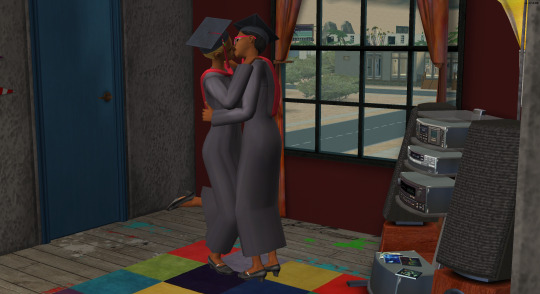
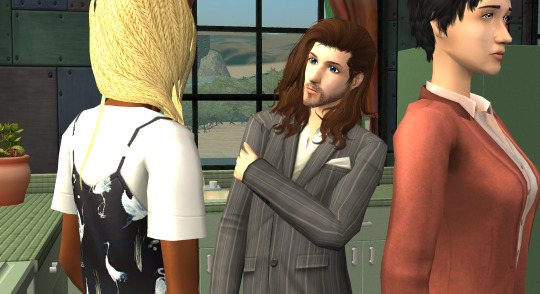
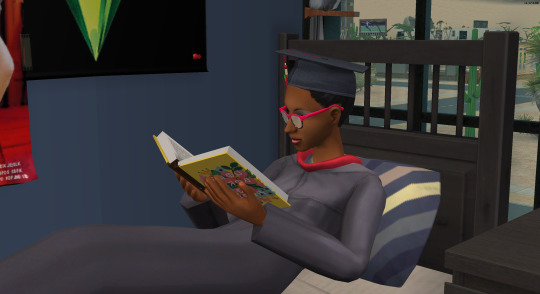
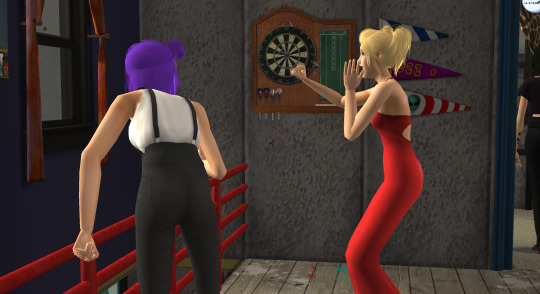

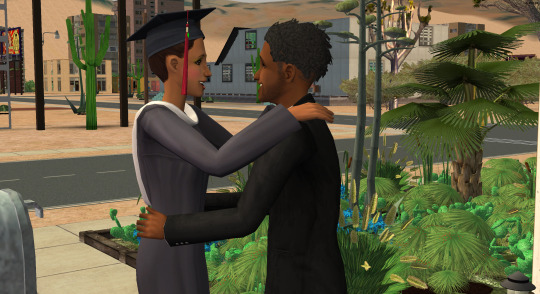

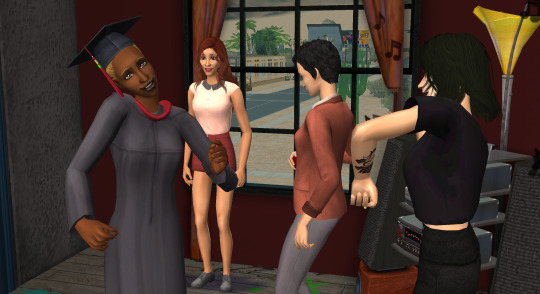

Graduation party time! As relieved as all three of them are to be graduating and moving on, I think in the long run they’ll look back on this period of their lives with fond nostaligia!
#Pleasantview Plus#University: LFT#Household: The Shifting Paradymes#PP: Jasmine Rai#PP: Zoe Zimmerman#PP: DJ Verse#PP: Allegra Gorey#PP: Jessie Pilferson#PP: Dirk Dreamer#PP: Gunnar Roque#PP: Sarah Love#PP: Ripp Grunt#PP: Ophelia Nigmos#i refuse to comment on ripp/ophelia flirting#how dare they after all this time!!!
25 notes
·
View notes
Photo




Everyone wants to use the bed at the same time :/ this living arrangement is getting more awkward every day.
#Pleasantview Plus#University: LFT#Household: The Shifting Paradymes#PP: Jasmine Rai#PP: Zoe Zimmerman#PP: DJ Verse#PP: Dirk Dreamer
23 notes
·
View notes
Photo



Dirk calls up Jasmine for another date, to celebrate her graduation. The streaker doing a little dance to see her taxi off made me LOL
#Pleasantview Plus#University: LFT#Household: The Shifting Paradymes#PP: Jasmine Rai#PP: Dirk Dreamer
21 notes
·
View notes